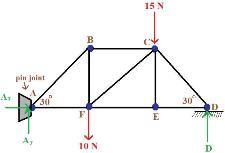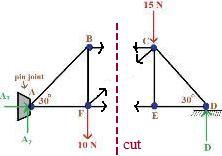LESSON 5: Method of Sections

The proper way to make a cut using the method of sections would look like this:

The cut can be made wherever is most convenient. If the problem insists on finding the values of a couple specific members of the truss, then make the cut through these specific members. You can pick either the left or right side of the cut to analyze. If you’re super cool maybe you’d like to analyze both sides… (note: it is possible to make a horizontal cut, in which case you’d pick either the top or bottom to analyze.)
When analyzing either side of the truss, treat the broken members as forces, just like you would as if they were never part of the truss at all. Just like in the method of joints, each member of the truss is assumed to be in tension, so if you get a negative value for one of the broken members, this means that the member is actually in compression. So, a positive value means the member is in tension and a negative value means it is in compression.
A link to an example problem is here: click to view problem. This is the same example problem as the example problem from the last section, except instead of being solved with the method of joints it is solved using the method of sections.

Tutorial Options:
Return to Home Page
Statics Lessons Home Page
Statics Example Problems
Continue to Next Section
Return to Home Page
Statics Lessons Home Page
Statics Example Problems
Continue to Next Section
Lesson 1:
Vectors
Magnitude
Unit Vectors
Cos Angles
Lesson 2:
Sum of Forces
Sum of Forces 2
Lesson 3:
3D Sum of Forces
Lesson 4:
Moments
Moments 2
Lesson 5:
Trusses
Method of Joints
Method of Sections
Lesson 6:
Distributed Load
Vectors
Magnitude
Unit Vectors
Cos Angles
Lesson 2:
Sum of Forces
Sum of Forces 2
Lesson 3:
3D Sum of Forces
Lesson 4:
Moments
Moments 2
Lesson 5:
Trusses
Method of Joints
Method of Sections
Lesson 6:
Distributed Load